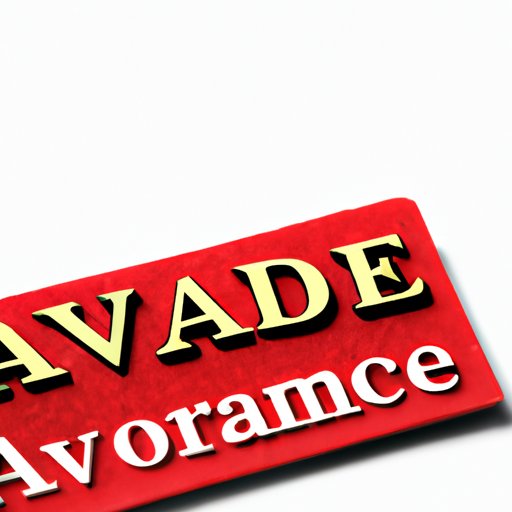
I. Introduction
Most credit cards offer a cash advance feature that allows you to borrow money against your available credit limit. This can be a convenient way to access quick cash in an emergency, but it’s important to understand the fees and interest rates involved. In this article, we’ll provide a comprehensive guide for getting a cash advance on your credit card, and also explore alternative options you may want to consider.
II. Step-by-Step Guide
A. How to access the cash advance feature on a credit card
To access the cash advance feature on your credit card, you can use your card at an ATM, or request a cash advance check from your credit card company. Note that not all credit cards offer this feature, so check with your card issuer beforehand.
B. Understanding the fees and interest rates associated with cash advances
Cash advances typically come with higher fees and interest rates compared to regular credit card purchases. You can expect to pay a cash advance fee of 2-5% of the total amount borrowed, as well as an APR of around 25%. Interest begins accruing from the day you take out the cash advance, so be sure to pay it back as soon as possible to minimize fees.
C. Tips for managing repayments
It’s important to understand the terms and conditions of your card’s cash advance feature before you borrow money. Make sure you budget for the repayment amount and schedule, as missed payments can incur additional fees and damage your credit score.
III. Pros and Cons
A. Advantages of getting a cash advance on a credit card
The main advantage of a cash advance is that it can provide you with quick access to cash in an emergency. You also don’t need to have a separate loan application as the cash advance is part of your credit card balance.
B. Disadvantages of getting a cash advance on a credit card
The main disadvantage of getting a cash advance on a credit card is the fees and high interest rates. Additionally, if you don’t manage your repayments effectively, you could end up with a higher amount than you initially borrowed, or even max out your credit limit, impacting your credit score.
C. Discussion of how the advantages and disadvantages weigh against each other
While cash advances offer a convenient way of accessing quick cash, it’s important to weigh the advantages against the disadvantages. If the fees and interest rates outweigh the benefit of quick cash, it may be worth considering alternative options.
IV. Alternatives to Cash Advances
A. Explanation of alternative methods for getting quick cash
There are several alternative options available if you need quick cash, including personal loans, payday loans, and cash advances from other lending institutions.
B. Comparison of the pros and cons of payday loans, personal loans, and other options
Each alternative has its own pros and cons. For example, payday loans can have even higher interest rates than credit card cash advances, while personal loans have lower fees but may require a longer application process. It’s important to research each option thoroughly.
C. Advice for finding the best solution for the reader’s individual needs
If you’re considering alternative options, be sure to read the fine print carefully and compare fees and interest rates. Always try to choose the best option for your individual needs and repayment ability.
V. How to Use a Cash Advance Responsibly
A. Practical tips for using a cash advance on a credit card responsibly
If you do decide to take out a cash advance, it’s important to use it responsibly. Only take out the amount you need, and be sure to budget for repayments. Consider setting a borrowing limit, and avoid using cash advances to pay regular bills or expenses.
B. Budgeting for repayments, setting borrowing limits, and avoiding additional fees
It’s crucial to budget for repayments and set affordable payment schedules, even if it means cutting back on non-essential expenses. Be aware of additional fees that may be incurred if you miss a payment.
C. Common pitfalls to watch out for and how to avoid them
Common pitfalls to watch out for include borrowing more than you can afford and missing payments. Be sure to read your credit card agreement in full and set up reminders for payment due dates to avoid missed payments.
VI. Comparing Different Credit Cards
A. Overview of cash advance options on various credit cards
Cash advance options vary between credit cards. Some issuers may have lower fees or offer lower interest rates for cash advances. Be sure to research your options before choosing a credit card.
B. Comparison of fees, interest rates, borrowing limits, and rewards programs
It’s important to compare fees, interest rates, and borrowing limits between different credit cards. Additionally, some credit cards may offer rewards programs that could benefit your spending habits.
C. Advice for choosing the best credit card for the reader’s needs
When choosing a credit card, consider your individual needs and spending habits. Be sure to compare fees, interest rates, borrowing limits, rewards programs, and other relevant factors before applying.
VII. Conclusion
Getting a cash advance on your credit card can be a convenient way to access quick cash, but it’s important to understand the fees and interest rates involved before borrowing. Additionally, there are several alternative options that may be more suitable for your individual needs. Always use cash advances and other borrowing options responsibly to avoid damaging your credit score and incurring unnecessary fees.




